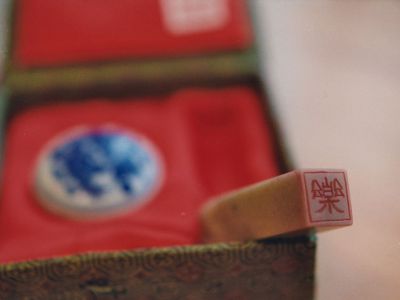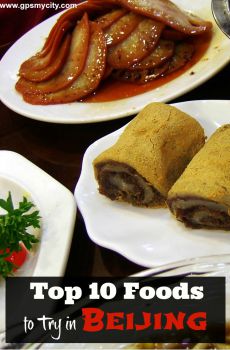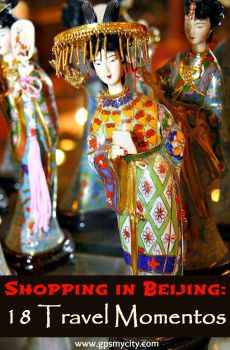
Hongqiao Market – The Pearl Market, Beijing
What to buy here: Chinese ceramics | Chinese chop | Chinese Jade | Chinese jewelry | Chinese silk | Chinese tea | Chinese Traditional Clothing | Cloisonne Objects | Yixing clay teapots | Zhongguo Jie (Chinese knots) |
The Chinese chop is a signature stamp made of stone or wood, sometimes metal or ivory. It is usually either square or circular in shape and almost always stamped with red ink. The chop was invented during the Shang dynasty and has since become an important part of Chinese culture. Traditionally, all business transactions had to be signed with a chop and to date no business can be done without the use of a chop, it is necessary to sign any agreement or contract. The Chinese chop is also used by Chinese artists in order to sign their works. Anyone can have their names translated into Chinese characters in order to make such a chop. The price for a Chinese chop is within $10, but it may cost more if the chop is made of precious stone.
Yixing clay teapots are a traditional style of teapots made of Yixing clay that have been produced since the 15th century. The Yixing teapots are meant to be used with black, oolong or pu'er tea, but may also be used with green and white tea. They are highly appreciated in China for their unique capability of absorbing the flavor of the tea that was made in it and adding from it to the next tea. That is why one pot is usually used for one single type of tea. If the pot has been used for years to make pu'er tea and then another kind of tea is made, it will have a taste of pu'er tea. These kind of pots may only be washed with boiled water, because if washed with soap or any other cleaning agent, it will retain its taste and the tea will taste like it. Since Yixing clay teapots are highly appreciated they tend to be more expensive than regular pots, the price for a Yixing clay teapot is approximately $30 to $40, but you may also find teapots that cost up to $1000.
The Chinese chop is a signature stamp made of stone or wood, sometimes metal or ivory. It is usually either square or circular in shape and almost always stamped with red ink. The chop was invented during the Shang dynasty and has since become an important part of Chinese culture. Traditionally, all business transactions had to be signed with a chop and to date no business can be done without the use of a chop, it is necessary to sign any agreement or contract. The Chinese chop is also used by Chinese artists in order to sign their works. Anyone can have their names translated into Chinese characters in order to make such a chop. The price for a Chinese chop is within $10, but it may cost more if the chop is made of precious stone.
Yixing clay teapots are a traditional style of teapots made of Yixing clay that have been produced since the 15th century. The Yixing teapots are meant to be used with black, oolong or pu'er tea, but may also be used with green and white tea. They are highly appreciated in China for their unique capability of absorbing the flavor of the tea that was made in it and adding from it to the next tea. That is why one pot is usually used for one single type of tea. If the pot has been used for years to make pu'er tea and then another kind of tea is made, it will have a taste of pu'er tea. These kind of pots may only be washed with boiled water, because if washed with soap or any other cleaning agent, it will retain its taste and the tea will taste like it. Since Yixing clay teapots are highly appreciated they tend to be more expensive than regular pots, the price for a Yixing clay teapot is approximately $30 to $40, but you may also find teapots that cost up to $1000.
Want to visit this sight? Check out these Self-Guided Walking Tours in Beijing. Alternatively, you can download the mobile app "GPSmyCity: Walks in 1K+ Cities" from Apple App Store or Google Play Store. The app turns your mobile device to a personal tour guide and it works offline, so no data plan is needed when traveling abroad.
Hongqiao Market – The Pearl Market on Map






Sight Name: Hongqiao Market – The Pearl Market
Sight Location: Beijing, China (See walking tours in Beijing)
Sight Type: Shopping
Sight Location: Beijing, China (See walking tours in Beijing)
Sight Type: Shopping
Walking Tours in Beijing, China
Create Your Own Walk in Beijing
Creating your own self-guided walk in Beijing is easy and fun. Choose the city attractions that you want to see and a walk route map will be created just for you. You can even set your hotel as the start point of the walk.
Olympic Park Walking Tour
The Olympic Park in Beijing was built for the Olympic and Paralympic Games of 2008. This modern complex represents a contemporary architectural approach as compared to the more traditional buildings that dominate the city. Among its signature items are the iconic Bird's Nest, otherwise known as the main Olympic stadium, and the beautiful Water Cube – the Aquatics Center for water sports.
... view more
Tour Duration: 2 Hour(s)
Travel Distance: 5.6 Km or 3.5 Miles
... view more
Tour Duration: 2 Hour(s)
Travel Distance: 5.6 Km or 3.5 Miles
Beijing's Historical Temples Tour I
Chinese temples are of unique beauty and have withstood many dynasties. However because the temples have always been connected to the imperial families, many of them were destroyed when the last dynasty ended in 1911. Nevertheless, a great number of beautiful temples with great history still stand in Beijing. Take this self-guided walking tour to discover a few famous temples in the northern part... view more
Tour Duration: 1 Hour(s)
Travel Distance: 0.9 Km or 0.6 Miles
Tour Duration: 1 Hour(s)
Travel Distance: 0.9 Km or 0.6 Miles
Beijing City Center Walking Tour
A political, cultural, and economic center of China for the past eight centuries, Beijing is the newest of the country's Four Ancient Capitals.
The city boasts the grandest and best preserved imperial palaces, gardens and temples, including seven UNESCO World Heritage sites, such as the Forbidden City, Temple of Heaven, Summer Palace, Ming Tombs, Zhoukoudian, and parts of the Great Wall... view more
Tour Duration: 2 Hour(s)
Travel Distance: 3.7 Km or 2.3 Miles
The city boasts the grandest and best preserved imperial palaces, gardens and temples, including seven UNESCO World Heritage sites, such as the Forbidden City, Temple of Heaven, Summer Palace, Ming Tombs, Zhoukoudian, and parts of the Great Wall... view more
Tour Duration: 2 Hour(s)
Travel Distance: 3.7 Km or 2.3 Miles
Beijing's Historical Temples Tour II
The places of worship are some of the best links to the city's history. The unique churches, Buddhist and Taoist Temples, and beautiful Muslim Mosques all tell great tales of the history of Beijing. Despite that many of them have been partially or completely destroyed over the years either by wars or by the changes of political power, a good number of them still remain. You can visit a few... view more
Tour Duration: 1 Hour(s)
Travel Distance: 2.1 Km or 1.3 Miles
Tour Duration: 1 Hour(s)
Travel Distance: 2.1 Km or 1.3 Miles
Useful Travel Guides for Planning Your Trip
Top 10 Foods to Try in Beijing
Centuries went by and the regional Chinese, Manchurian, Mongol and Muslim cuisines boiled together to produce what's now known and loved as traditional Beijing cooking. Whenever you're in the Chinese capital, don't leave without tasting at least some of the key local meals or your...
Best Street Foods to Try in Beijing
China's passion for food – long in history as The Great Wall of China itself – is clearly manifested in its street food culture. This is particularly noticeable on the streets of Beijing, teeming with numerous vendors and thick with aromas. Whether you're a vegan, vegetarian or a...
Most Popular Desserts and Drinks in Beijing
No meal is complete without a sweet touch and a proper drink to wash it all down. Beijing's food scene is rich and colorful in many ways, and the dessert & drink areas are no exception. Some of the signature Beijing delicacies have gained popularity across Asia over the centuries, whereas...
Shopping in Beijing: 18 Travel Mementos
Today, it is safe to assume that 9 out of 10 souvenirs worldwide (regardless of the country) are made in China, the workshop of the world. But how about shopping for souvenirs in China itself and Beijing, in particular? Presented here are some of the traditional Chinese-made goods, initially...








